“I do not know how I seem to others, but to myself I am but a small child wandering upon the vast shores of knowledge, every now and then finding a small bright pebble to content myself with.” – Plato
Dolphins are a mystery. They are not fish even though they look like fish. Nor are they humans, even though they think and feel like humans. Well, then who or what are they?
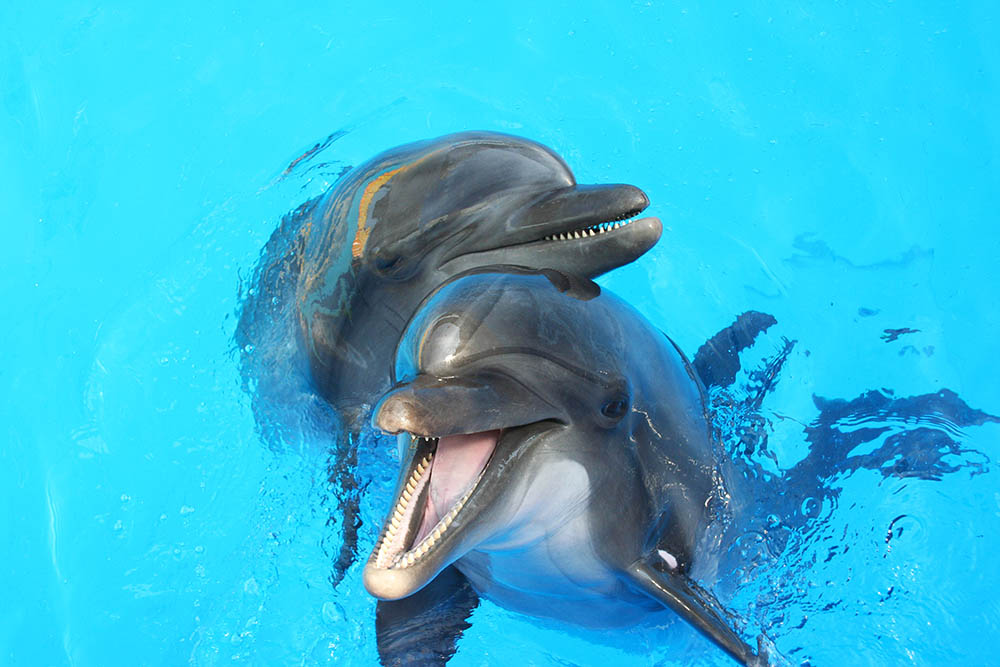
Dolphins are marine mammals of the cetacean family. They have a sense of echolocation, i.e. the ability to emit and receive high-frequency sound waves to navigate and locate food and threats (it is good to know if the herd of sharks passing nearby are well fed or still hungry for more). Most probably, echolocation in dolphins was developed in the course of evolution based on their ability to hear ultrasounds. It works like a sonar: sound waves emitted by a dolphin return to it when rebound from external objects, enabling the creature to precisely recognize his or her surroundings within a radius of several kilometers.
Research of the dolphin brain has led to the discovery of a hollow chamber: a cavity resonator which may play a role in telepathic communication and highly abstract thinking. The cerebral cortex in humans is extremely similar, in fact nearly identical, to that in dolphins. This means that the two species receive and process information in a similar manner and have the ability to distinguish stimuli and communicate. All of us have heard dolphin squeaks, whistles and clattering. In fact, this is a very complex language with its own grammar and dialects. Dolphins call each other by name (as each one of them has a name and belongs to a certain family and pod) and exchange information. And as the following description of a study demonstrates, they also agree among themselves on which course of action to take:
“Teri puts her hands together over her head – this is the “think something up” command. She then shows two fists put together, meaning “together, the two of you”. The message conveyed by these gestures is a request for the dolphins not only to show something new but also to do it together at the same time. Hector and Han disappear under the surface where they are watched by Stan Kuczaj, a specialist in comparative psychology (formerly referred to as animal psychology). He carries a camera and microphones with which he records some 15 seconds of loud “chirps”. Then the two dolphins perform a simultaneous turn and flap their tail fins three times on the surface of the water. Teri puts together her thumb and middle finger, asking the dolphins to continue thinking up more tricks together. The two 180-kilogram creatures plunge under the surface again, exchange a few squeaky sounds and simultaneously blow a cloud of air bubbles. Then they perform a synchronous pirouette and “walk hand in hand” on their tails on the surface of the water. Eight perfectly synchronized tricks later the session ends” –according to a study published by the Roatán Institute for Marine Sciences (a scientific and educational center on the island of Roatán off the coast of Honduras).
Unfortunately, even though scientists have studied dolphin communication for half a century now, they have been unsuccessful in understanding the distinct units and interdependencies of dolphin speech. Should we therefore continue trying to measure their intelligence and understand them?[1]
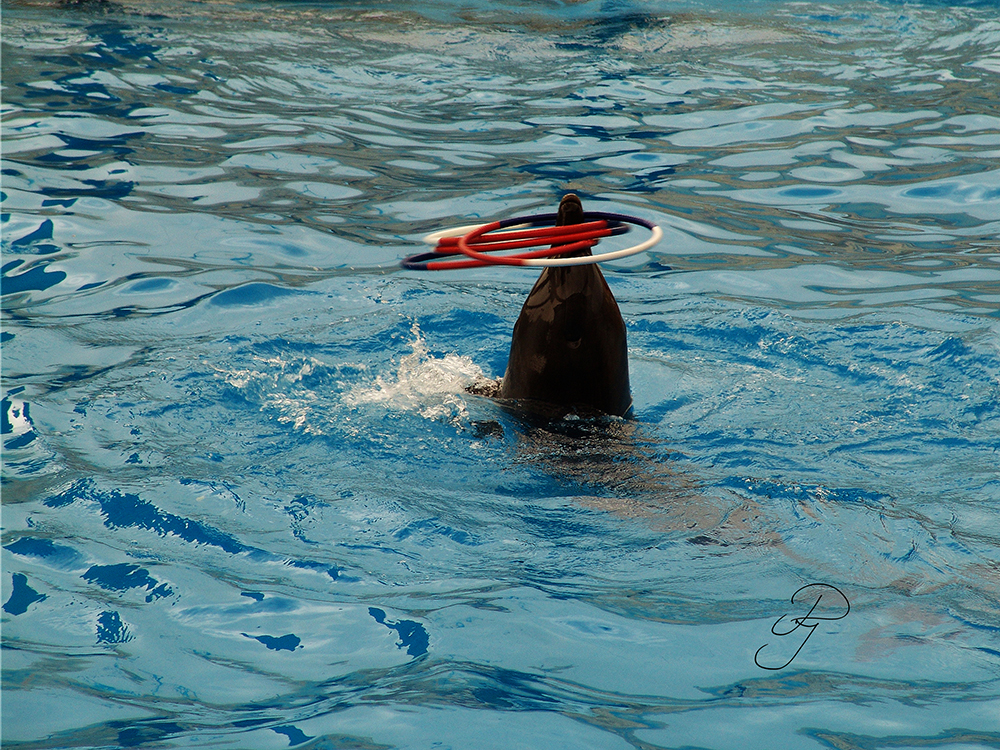
Photo by Paulina Jarkiewicz
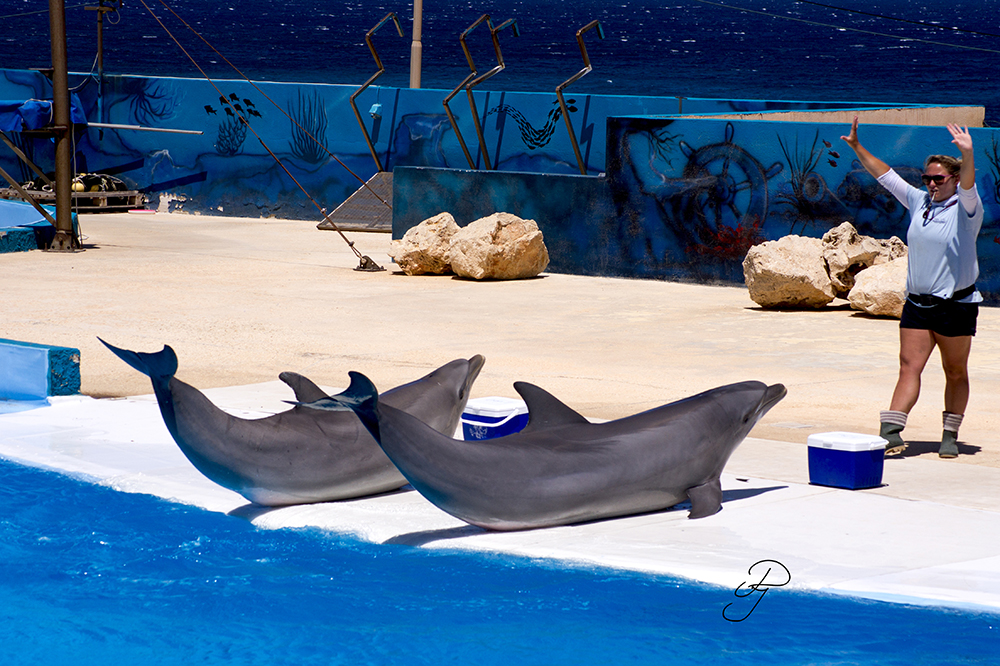 Photo by Paulina Jarkiewicz
Photo by Paulina Jarkiewicz
Dolphins in mythology
Already in ancient times dolphins were worshiped and were considered magical animals.
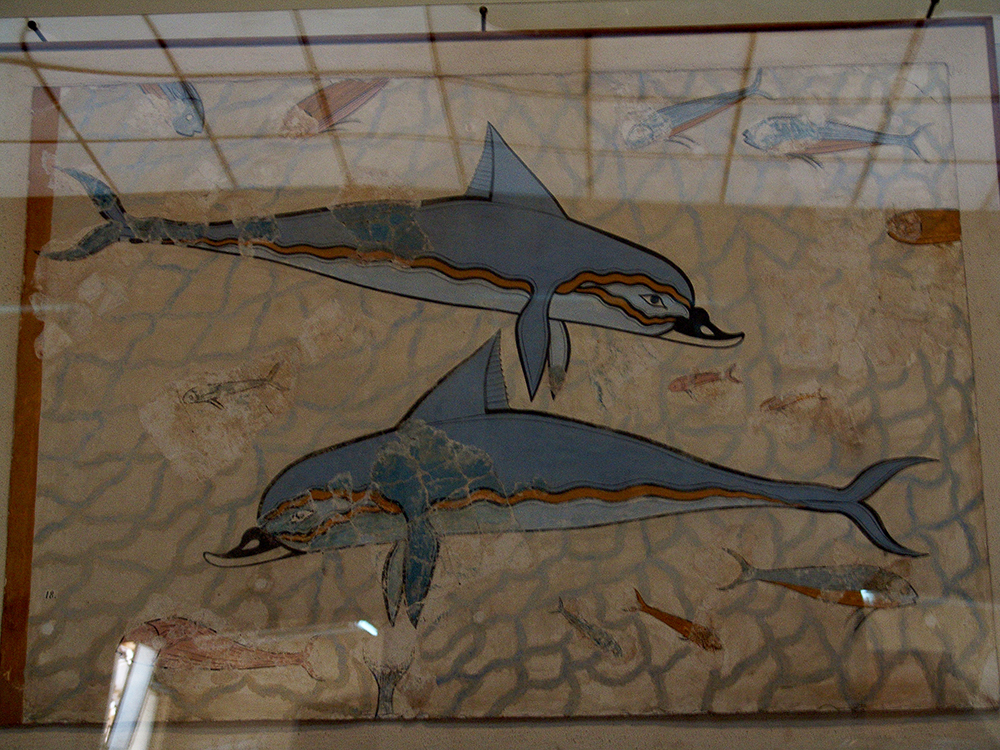
Crete, the Heraklion Archaeological Museum (fresco from the queen’s chamber in Knossos, dated to around 600 BC), photo by Paulina Jarkiewicz
In legends, dolphins relocated human souls to the underworld where they rested, relaxed and selected a new incarnation. They supported and rescued sailors. According to Aborigines, they came to Earth from the constellation Sirius to provide humans with joy and teach us spontaneity. They were and continue to be a symbol of happiness.
Healing power of dolphins
Echolocation enables dolphins to scan human energy field. By emitting sound waves, they cleanse our bodies of accumulated toxins, bad energy and stress, remove energy locks, enhance our self-healing ability and provide us with additional strength, self-confidence, power and joy. “According to some hypotheses, dolphin sonars are able to stimulate the production of certain hormones by modifying brain waves and causing various soft tissues of the human body to open up and create more space”.[2]
In the 1970s, dolphin-assisted therapy (DAT) was developed. It is applied to support the medical treatment of cerebral palsy, autism, Down syndrome, chronic depression and recovery after myocardial infarction, cancer and a number of other diseases.
Dolphinariums
I know that a lot has been said about enslaving dolphins. The idea of building a dolphinarium in Poland was halted. I admit that catching dolphins living in the wild to keep them captive in closed dolphinarium pools for the amusement of people is a reprehensible idea. Campaigns have been launched aimed at freeing dolphins kept in captivity. They require considerable effort, involvement and funds.
But there are dolphinariums, like the one in Klaipeda, Lithuania, that breed dolphins in captivity. Currently, only two aging inhabitants of the Klaipeda Dolphinarium once lived in the wild. Of course, dolphins born in captivity neither experience freedom nor swim large distances in the seas and oceans. But the other side of the coin is that they avoid many risks, are well cared for and loved, and a number of people take care of their comfort and well-being.
Let us also remember that during dolphin shows these animals perform activities that reflect their plays in the wild. Learning new tricks stimulates their development. Positive contacts with humans may be beneficial to both dolphins and people. A dolphin show provides a lot of positive energy. I know people who shed tears of emotion during a show (I have experienced it myself), relieving tension and stress.
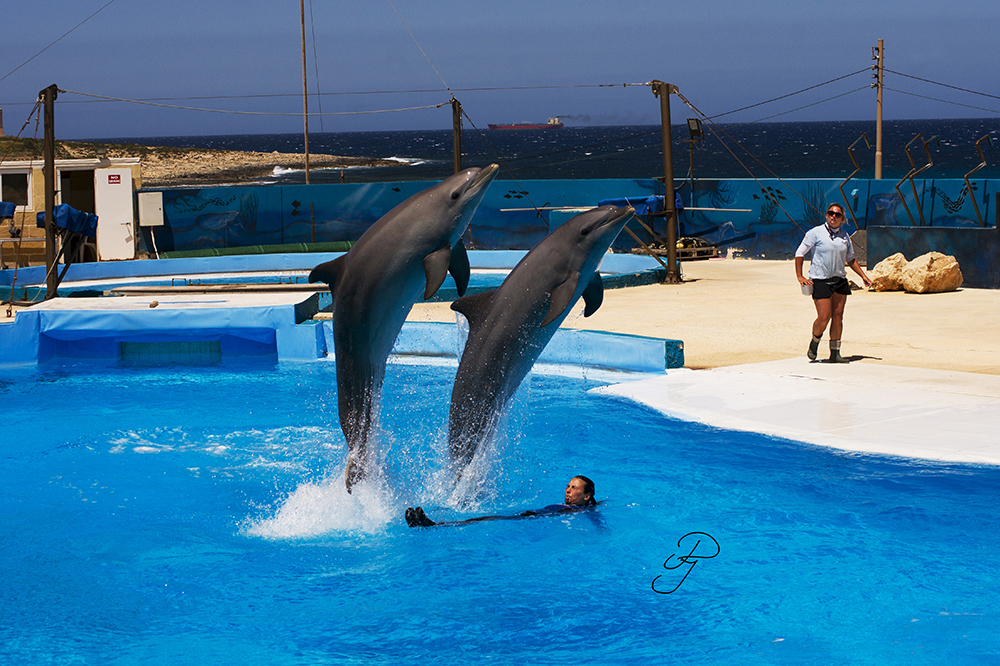 Malta Marine Park, photo by Paulina Jarkiewicz
Malta Marine Park, photo by Paulina Jarkiewicz
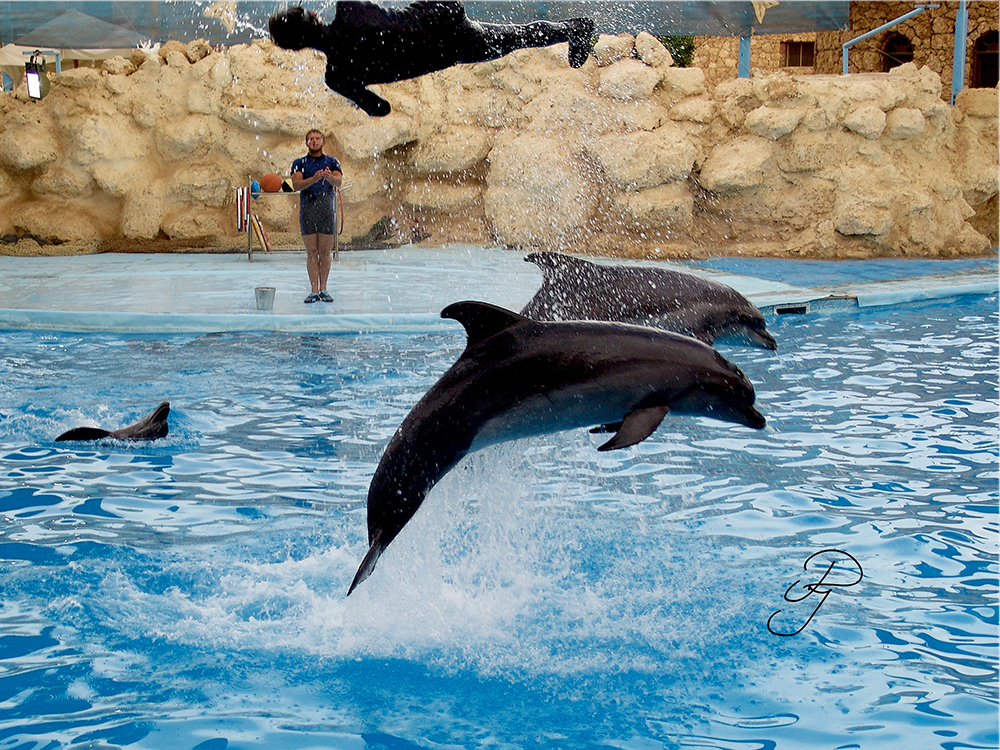 Dolphina Park, Sharm El Sheikh, photo by Paulina Jarkiewicz
Dolphina Park, Sharm El Sheikh, photo by Paulina Jarkiewicz
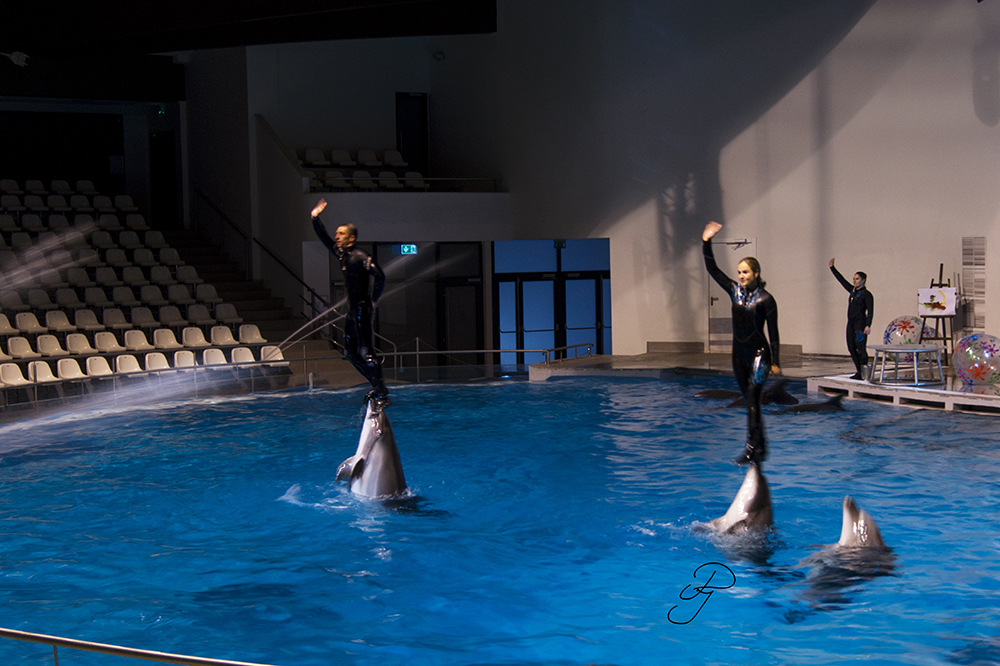 Klaipeda Dolphinarium, photo by Paulina Jarkiewicz
Klaipeda Dolphinarium, photo by Paulina Jarkiewicz
Moreover, therapies are organized in which dolphins play an important role. This is useful work that has already helped a number children and adults suffering from emotional disorders.
This form of therapy not only provides perfect relaxation in water, which is an environment resembling our first months in the mother’s womb, but is also great fun. You float on the water with your head or feet supported on the back of a dolphin. You close your eyes and feel the rocking motion of the water. It is an incredible ‘fly away’ kind of experience.
We should realize that these extraordinary creatures, somewhere at a higher level, have made the decision to help us by agreeing to live in captivity for the sake of greater ideas. Let us respect them for this gift.
Let us protect their habitats so that their lives in the wild are not so onerous. The dolphin’s worst enemy is the human: our fishing nets and our garbage. Let us stop polluting and littering their habitats. Let us not create any new dolphinariums. Let us not catch and put them in captivity to make money at their expense.
Rather, let us adopt their approach to life: the natural joy of being and enjoying every single day. Let us appreciate their patience and willingness to help, their spontaneity and joyfulness.
[1]“Humans and dolphins – it is time we talk to each other”], National Geographic Poland, 5 May 2015.
[2]Lucy Cavendish, “Zagubione lądy. Magiczna historia Lemurii, Atlantydy i Avalonu” [Polish translation of “The Lost Lands: A Magickal History of Lemuria, Atlantis & Avalon”], Warsaw 2011, p. 166.
Prepared based on the following publications:
1. Lucy Cavendish, “Zagubione lądy. Magiczna historia Lemurii, Atlantydy i Avalonu” [Polish translation of “The Lost Lands: A Magickal History of Lemuria, Atlantis & Avalon”], Warsaw 2011
2. “Ludzie i delfiny, czyli pora porozmawiać” [“Humans and dolphins – it is time we talk to each other”], National Geographic Poland, 5 May 2015
3. “Delfiny zupełnie jak nietoperze. Echolokacja i ultradźwięki” [“Dolphins are like bats. Echolocation and ultrasounds”], Polish Press Agency PAP, 8 August 2016;
4. “Delfiny też mają imiona” [“Dolphins also have names”], Polish Press Agency PAP, 12 November 2013;
5. Wikipedia.
